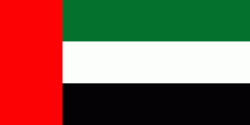Khor Fakkan (Khawr Fakkān)
 |
It is also a popular spot among domestic tourists due to its white sand beaches and coral reefs that attract many marine life enthusiasts. Khor Fakkan beach lies to the north of the center of the town. Khor Fakkan is located on the east coast of the UAE, between the Shumayliyah Mountains and the Arabian Sea, with an altitude of 1,023 meters (3,356 ft) at al Hilqah Mountain (Jebel al Hilqah). The bay of Khor Fakkan faces the northeast and is protected from prevailing winds by a jetty serving terminal for container ships. In the mountains of Khor Fakkan and off the Sharjah-Khor Fakkan highway lies the Rifaisa Dam that is considered to have been built over a village, and thus when the water is very quiet, the tops of the old houses are visible. The development of Al Rifaisa Dam spans an area of 10,684 square meters.
Khorfakkan has a long history of human settlement. There is evidence of post holes from the wooden uprights of the traditional barasti huts known as areesh, similar to those found at Tell Abraq which dates from the 3rd to 1st millennium BC. Excavations by a team from the Sharjah Archaeological Museum have identified 34 graves and a settlement belonging to the early-mid 2nd millennium BC. These are clustered on rock outcrops overlooking the harbor.
Around 1500, Duarte Barbosa described it as a village “around which are gardens and farms in plenty”. The town was captured by the Portuguese Empire in the 16th century by naval commander General Afonso de Albuquerque over 500 years ago, and was referred to as Corfacão. It was part of a serial of fortified cities that the Portugal had to control the access to the Persian Gulf and the Gulf of Oman, like Khor Fakan, Muscat, Sohar, Seeb, Qurayyat and Muttrah. The settlement, located on the east coast of the Musandam peninsula, south of the Gulf of Oman, was a tributary of the kingdom of Hormuz. At the dawn of the 16th century, it and its port were defended by a wide walled belt facing the land, closing the gorge that, in the mountain range parallel to the coast, allows communication with the interior. In this monumental structure a single door was torn, defended by a tower. The ensemble was responsible for safeguarding eventual tribal attacks.
In 1580 the Venetian jeweler Gasparo Balbi noted "Chorf" in a list of places on the east coast of the United Arab Emirates, which is considered by historians to indicate Khor Fakkan. The Portuguese built a fort at Khor Fakkan that was a ruin by 1666. The log book of the Dutch vessel the Meerkat mentions this fort and another one, describing "Gorfacan" as a place on a small bay, with about 200 small houses built from date branches, near the beach. It refers to a triangular Portuguese fortress on the northern side, in ruins, and a fortress on a hill on the southern side, also in ruins, without garrison or artillery. As well as date palms, the Meerkat's log also mentions fig trees, melons, watermelons and myrrh. It notes several wells with "good and fresh water" used for irrigation. One reason suggested for the ruinous state of the forts is an invasion in 1623 of the Persian navy under the control of Omani Sheikh Muhammad Suhari. Suhari, facing a Portuguese counterattack, withdrew to the Portuguese forts, including that of Khorfakkan. When the Persians were expelled, the Portuguese commander Rui Freire urged the people of Khorfakkan to remain loyal to the Portuguese crown and established a Portuguese customs office as well.
In 1737, long after the Portuguese had been expelled from Arabia, the Persians again invaded Khor Fakkan, with some 5,000 men and 1,580 horses, with the help of the Dutch, during their intervention in the Omani civil war. In 1765 Khor Fakkan belonged to a sheikh of the Al Qasimi, Sharjah's ruling family, according to the German traveler Carsten Niebuhr. There is a map by the French cartographer Rigobert Bonne dating to about 1770 that shows the Arabian Peninsula and the Persian Gulf and includes Khor Fakkan.
At the turn of the 19th century, Lorimer notes that Khor Fakkan had about 5,000 date trees and was home to about 150 houses of Naqbiyin and Arabicised Persians, amounting to some 800 people. The population lived by cultivation and pearling, and the town had seven shops.
The German submarine U-533 sank about 25 mi off the coast on 16 October 1943 during World War II. Divers found the wreck at a depth of 108 m in 2009.
Map - Khor Fakkan (Khawr Fakkān)
Map
Country - United_Arab_Emirates
 |
 |
| Flag of the United Arab Emirates | |
The United Arab Emirates is an elective monarchy formed from a federation of seven emirates, consisting of Abu Dhabi (the capital), Ajman, Dubai, Fujairah, Ras Al Khaimah, Sharjah and Umm Al Quwain. Each emirate is governed by an emir and together the emirs form the Federal Supreme Council. The members of the Federal Supreme Council elect a president and vice president from among their members. In practice, the emir of Abu Dhabi serves as president while the ruler of Dubai is vice president and also prime minister. In 2013, the country had a population of 9.2 million, of which 1.4 million were Emirati citizens and 7.8 million were expatriates. , the United Arab Emirates has an estimated population of roughly 9.9 million.
Currency / Language
| ISO | Currency | Symbol | Significant figures |
|---|---|---|---|
| AED | United Arab Emirates dirham | دإ | 2 |
| ISO | Language |
|---|---|
| AR | Arabic language |
| EN | English language |
| HI | Hindi |
| FA | Persian language |
| UR | Urdu |















